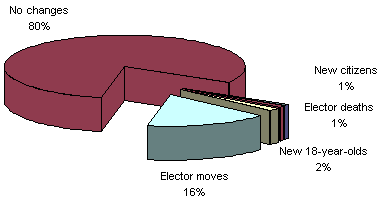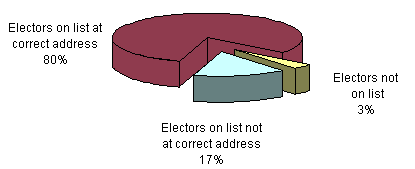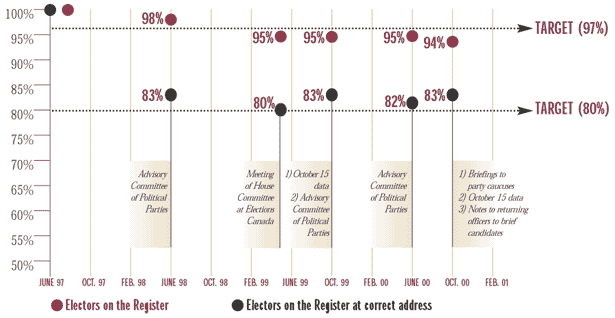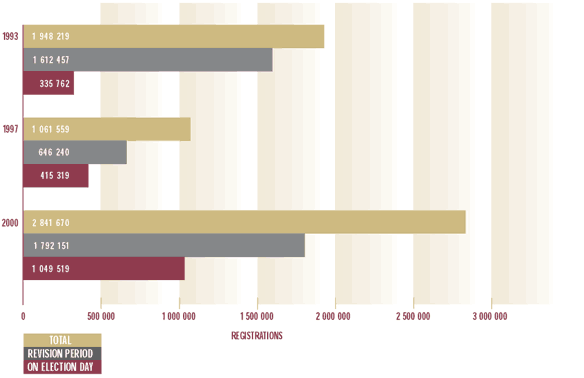Report of the Chief Electoral Officer of Canada on the 37th General Election Held on November 27, 2000
Preparing the voters lists
The day the election was called, Elections Canada staff sent electronic files and printed copies of each riding's preliminary voters lists to the returning officer – 301 sets of lists with the names and addresses of nearly 19.4 million electors. This was the first general election for which the preliminary lists were produced entirely from the National Register of Electors and the registers of international and Canadian Forces electors.
The Register's data quality
In our 1996 study of the Register's feasibility, we indicated that our reliability target was 80 percent, based on the 1993 experience of successfully conducting a general election using a one-year-old final voters list that had declined to an average 80 percent level of reliability during the year. As Figure 1 shows, voter information inevitably changes over the course of a year. This happens because of demographic changes: some people move, some die, and others become eligible to vote by turning 18 or receiving Canadian citizenship.
Figure 1
Annual demographic changes in electoral population

Through comparisons between lists of electors dating back to 1984 and Statistics Canada census data, we know that an average of five percent of electors (about a million Canadians) are not included on the voters lists, even with door-to-door enumeration. This five percent was, therefore, not included in our calculation of quality targets. Figure 2 indicates our quality targets for the preliminary lists.
Figure 2
Quality target for preliminary lists

Since the 1996 feasibility study, we have adopted a more effective method of measuring the quality of the Register's data. This involves two measurements: coverage (the percentage of all electors who are listed) and currency (the percentage of electors listed at the correct address). Using these measures, the Register's quality targets for the 2000 general election were to have 97 percent of electors included, and 80 percent of electors listed at the correct addresses.
Since June 1998, Elections Canada has regularly reported to members of Parliament and political parties on our estimates of the quality of the information in the Register. Data quality analyses are provided with the voters lists sent annually to MPs and political parties. Figure 3 shows the various briefings that have taken place.
Figure 3
Reports on Register data quality

By fall 2000, we were very close to our quality target. We estimated the proportion of electors listed in the Register to be 94 percent, slightly lower (by three percent) than our reliability target, owing largely to the low proportion of new 18-year-olds added to the Register. We estimated the percentage of electors listed in the Register at the correct addresses to be 83 percent, slightly above our reliability target. Overall, the quality of the 2000 preliminary lists was comparable to that of the preliminary lists used for the 1993 general election. We had procedures and resources in place for what we expected to be some 3 million changes to the preliminary lists during the revision period of the election.
Figure 4
Quality of 2000 preliminary lists

Four iterations of the voters lists
Although Canadians commonly refer to the voters list, in fact there are four different lists for each polling division in any general election or by-election: the preliminary, revised, official and final voters lists.
The preliminary lists for each riding are produced by Elections Canada and sent to the returning officers immediately following the issue of the writs. The returning officers provide an electronic and a printed copy to candidates when their nominations are confirmed.
Each returning officer produces revised voters lists for the riding 10 days before election day, and sends an electronic and a printed copy to confirmed candidates. The revised lists include additions, removals, corrections and address changes made to the preliminary lists during revision, and are used during voting at the advance polls. The names of people who registered to vote by special ballot are marked with an S, to indicate that they cannot vote a second time at the advance polls or on election day.
Three days before election day, the returning officer distributes electronic and printed copies of the official voters lists to candidates. Each deputy returning officer receives a copy of the official list for his or her polling division. The official lists reflect removals from, and additions, corrections, and address changes made to the revised lists. The names of people who voted at the advance polls are crossed off the official lists, to indicate that they cannot vote again on election day.
After election day, returning officers prepare electronic lists that include voters who registered on election day, and send them to Elections Canada. There, staff prepare electronic and printed copies of the final voters lists to be distributed to registered political parties and members of Parliament.
Revision
The process of adding new names to a voters list, correcting existing information and removing names is known as revision.
The formal revision period lasted for four weeks, from October 25 to November 21 (so that the official voters lists could be produced the following day), although unregistered voters could still register to vote on election day itself, November 27. To respond to revision requests from electors, each returning officer appointed revising agents selected from lists provided by the registered political parties whose candidates came first and second in the riding during the previous election. Elections Canada estimated the projected volume of revision requests for each riding, and advised the returning officer, who could use this information to determine staffing levels. Returning officers, in turn, were asked to inform the candidates.
An elector may want to be registered because he or she has recently acquired Canadian citizenship or turned 18, or may never have registered to vote before. If the elector is already registered, he or she may want to correct existing information, such as a name, civic address or mailing address; to report a recent change of address; to be removed from the voters list for personal reasons; or to remove a former resident from the list because that person either has died or has moved.
We devised revision procedures to make them convenient for electors, while respecting the need to maintain the integrity of the electoral process. If an elector has moved within the riding, for instance, or a previous occupant must be removed from the list, both changes can be done over the phone, with appropriate identification checks. If an elector was previously on a voters list in another riding and has moved, the change requires a signature on the application form, but not proof of identity. Identification is required only if the elector is not already listed somewhere in the Register.
Special initiatives
To improve the accuracy of the preliminary and revised voters lists, Elections Canada undertook several special projects based on last-minute information that we received from outside sources immediately before and during the first week of the election. The results gave returning officers a head start on their revision activities, helping to reduce their reliance on elector-initiated revisions and registrations at the advance or ordinary polls.
Information from Canada Post allowed us to modify some 388 000 place names in mailing addresses to meet the corporation's delivery standards, and to update more than 48 000 rural mailing addresses in New Brunswick and another 14 000 post office box addresses nationally. We completed the project in time to correct the data for the voter information card mailing labels. We are improving our address management procedures to capture such large-scale changes in the future without waiting for scheduled updates.
We were able to determine the polling division numbers for 197 000 electors for whom address changes had been made recently in the Register, but who had been left off the lists because their addresses were not yet assigned to polling divisions. We printed revision forms for these electors and shipped them to returning officers, who added the names to the preliminary voters lists before they mailed out the voter information cards. This matter will be resolved, for the most part, once we have completed our geo-referencing activities before the redistribution of electoral boundaries that will follow the 2001 census.
We received new elector data from Alberta, Manitoba and Quebec just before and immediately after the writs were issued. Normally, the information would have been incorporated into the Register during its next scheduled update cycle. Instead, we were able to accelerate the process over a two-week period, and provide an additional 481 400 revisions to returning officers. With information received from the Chief Electoral Officer of Alberta, we updated the addresses of 120 000 voters, based on the late summer provincial confirmation, and added 67 000 new 18-year-olds. The release of a one-year backlog of data from the Manitoba Registrar of Vital Statistics allowed us to remove the names of 8 400 deceased people before the voter information cards were mailed. And a release from the Directeur général des élections du Québec gave us data to incorporate 217 000 elector moves and 45 000 new 18-year-old electors, and remove the records of 24 000 electors who had died.
In Quebec, young electors who have just turned 18 are automatically added to the provincial voters lists, and the information is passed on to the National Register of Electors. Elsewhere in Canada, we write to these new electors to get their consent to have their names added to the Register and to confirm their citizenship. At the beginning of the election, we sent registration reminder letters to 428 000 young people who turned 18 after the 1997 general election. This included 373 000 who had previously been invited to list their names in the National Register of Electors, but had not responded, and 55 000 newly identified 18-year-olds.
Targeted revision
Targeted revision, an important activity that returning officers carried out during the second week of the election period, was directed at specific areas where electors are less likely to appear on the voters lists at their current home addresses. Returning officers were required to determine these areas after consulting political parties and MPs as part of event preparations in spring 2000. In general, they concentrated on recently developed areas such as new subdivisions, areas known for high mobility, including clusters of apartment buildings and student residences, and institutions such as nursing homes and chronic care hospitals.
Pairs of revising agents visited the targeted areas and took registration information directly at the door, or if no one was home after two visits, left a mail-in registration package for residents. Registering at the door was more convenient for electors – if they mailed in their registrations, they would have to fill in a form, and provide photocopies of identification documents. Preliminary statistics show that revising agents visited approximately 515 000 addresses, and completed registration forms for 192 000 households, reaching an average of 1.7 electors per household. The information on the preliminary lists for all electors at 174 000 of the addresses visited was confirmed as correct. The targeted revision exercise provided effective coverage of high-mobility areas; Table 4 shows the details.
| Number of addresses visited | 515 000 |
| Number of forms completed | 192 000 (37% of addresses visited) |
| Number of kits left at the door | 149 000 (29% of addresses visited) |
| Number of addresses where registrations were confirmed | 174 000 (34% of addresses visited) |
The voter information card
Ten days after the election was called, most returning officers began to mail out personalized voter information cards to everyone whose name appeared on the preliminary voters lists. Each card showed the name and address of the registered elector, the location, dates and hours of voting at the advance polls and on election day (polling stations with level access were marked with a wheelchair symbol), and the address, telephone number and office hours for the office of the riding's returning officer. While Elections Canada supplied the address labels, generated from Register data, returning officers provided the local voting information that appeared on the cards, and arranged the printing and mailing. Returning officers also mailed or handed voter information cards to persons they added to the lists through targeted revision and other special initiatives.
After the elector's name, the label included the words "or occupant." Because the purpose of the cards (as well as confirming registration) was to inform as many people as possible about where they could vote, and where to call if they were not registered, Elections Canada had arranged with Canada Post that cards addressed to people who had moved should not be redirected. By including "occupant" in the address, we encouraged the electors who would not receive their own cards to read the important returning officer and voting information for their address. They could then contact the returning officer to register, and have the former occupants' names removed.
Before the voter information cards were mailed, a householder pamphlet was delivered to every residence in the country, giving basic information on the election and alerting electors to expect the cards. The mailing of the card was accompanied by extensive Elections Canada advertising on television, radio and popular Web portals, as well as in daily and weekly newspapers. Returning officers' staff were trained in procedures they should follow to answer electors' questions and requests.
Despite our efforts to make sure that all mailing addresses in the Register were valid, we knew that some cards would probably be returned by Canada Post as undeliverable. Some addresses in New Brunswick required special attention, because the province had converted rural route addresses to numbered civic addresses for the 911 emergency telephone system. In the end, only 100 000 cards were returned across the country, or about 0.5 percent of the national mailing. Returning officers received outstanding co-operation from Canada Post and its local coordinators in resolving problems. If an elector did not receive an information card, or received one that required corrections, our advertising program encouraged him or her to contact Elections Canada. In a few ridings, the cards were mailed out several days late; since our television, radio and daily newspaper advertising was timed to coincide with the cards' arrival, these delays increased the number of calls to our toll-free enquiries line.
The effectiveness of revision
By the time the polls closed on election day, we had handled more than 3.6 million revisions, including electors registered at the door during targeted revision and the special initiatives data sent to returning officers by Elections Canada early in the campaign. Some 63 000 electors registered during the advance polls, and almost 1.05 million on election day. We had projected 660 000 election day registrants, based on our estimates of the quality of the preliminary voters lists and the volume of revisions processed during the election. We were prepared for a million.
The Chief Electoral Officer contacted all returning officers a week before election day, asking them to be prepared for extra registrations. Seventy ridings were identified as likely to have especially high volumes of registrants on election day, and preparations for election day were tracked closely in those ridings. The Chief Electoral Officer authorized every returning officer to increase the number of registration officers and their working hours as required. Returning officers were authorized to keep teams of registration officers on call, ready to help out wherever and whenever necessary. In all cases, returning officers were asked to consult the candidates about registration plans for election day, and to take their comments into account.
Table 5 summarizes our projected revision figures and the actual number of changes in the lists. For the entire election period, we had projected a little more than 3 million changes, including changes issuing from targeted revision, special initiatives, registrations at advance polls and on election day, and all other revision activity. The actual number of changes was about 650 000 higher than we estimated. Some of the difference resulted from an increase in corrections (primarily to addresses), most of which did not affect the delivery of the voter information card. While the number of removals from the lists was slightly lower than expected, the number of registrations (including those resulting from moves) was 16 percent higher than we estimated. As Figure 5 shows, most of the difference between projected and actual registrations came from Alberta and Quebec, despite the last-minute update information sent to returning officers.
| Nature of change | Projected | Actual | Difference (Actual – Projected) |
|---|---|---|---|
| Additions and address changes | 2 454 600 | 2 841 670 | 387 070 |
| Removals | 442 300 | 416 393 | –25 907 |
| Corrections | 124 100 | 413 428 | 289 328 |
| Totals | 3 021 000 | 3 671 491 | 650 491 |
Figure 5
2000 election revisions – Additions and address changes

The effectiveness of the National Register of Electors, combined with the revision process, in producing viable voters lists had previously been tested only in by-elections. This first nationwide use of the Register met our expectations in terms of overall performance, and showed that the Register is, generally, an effective source of data for establishing the preliminary lists.
Our post-election evaluation includes an assessment of the complete elector registration process, and how we can refine our tools and planning techniques. The difference of 650 491 between projected and actual revisions to the lists amounts to three percent of all electors on the final lists – it poses questions to be answered, and a challenge in preparing for the next election.
We are constantly working to improve the quality of the Register data, as well as our methods of estimating the Register's data quality, based on information from this election.
We must also assess the impact on revision figures of various events during the election campaign itself. For instance, the last-minute data that we sent to returning officers in Alberta and Quebec resulted in changes to the lists recorded by the returning officers as revisions. However, some individuals whose information was revised based on this data might have had to make additional changes to their elector information during the election.
Although the interests of efficient electoral administration suggest that as many list revisions as possible be completed before election day, the option of election day registration is now widely known through Elections Canada's advertising and voter information programs. It is entirely possible that a large proportion of voters will continue to choose to register on election day. In this context, Elections Canada's special preparations for election day registration were prudent, since more voters registered at the polls in 2000 than at either of the two previous general elections, as Figure 6 shows.
Figure 6
Distribution of additions and address changes –
Historical comparisons

It is important to note that more than 3.6 million changes were successfully recorded during this election. This is not only a tribute to the staff in the local offices and at Elections Canada, but also underscores the importance of effective information programs and the significance of revision as a central part of a permanent voters list system.
Registered political parties
A political party that wishes to participate in a federal general election or by-election may apply to register with the Chief Electoral Officer. Registration confers several advantages, such as inclusion of the party name on the ballot with the candidates it endorses, the right to issue tax receipts for political contributions, an allotment of guaranteed paid and free broadcasting time, and partial reimbursement of the party's election expenses if it qualifies.
The registration process starts when Elections Canada receives the party's application for registration, which must be submitted at least 60 days before a general election is called. The application must include information about the party, the leader of the party, its officers, chief agent and auditor, and be signed by 100 electors who are party members. The Chief Electoral Officer ensures that the party's name and logo are not likely to be confused with other party names and logos; he also mails a questionnaire to each of the 100 electors, who must confirm that they are party members. The party is registered when all the application requirements are met, and the Chief Electoral Officer verifies that the party has nominated confirmed candidates in at least 50 ridings in a general election. If a party fails to nominate 50 candidates, it will lose its registered or eligible status, will be subject to third party election advertising limits, and will not be eligible for a variety of other benefits under the Canada Elections Act. It will not, for instance, be able to issue tax receipts to contributors or qualify for reimbursement of a portion of its election expenses. The party can reapply for registration for the next election.
| How many candidates? The question of determining the point when a political party becomes registered has been before the courts recently in the case of Figueroa v. Canada (Miguel Figueroa is the current leader of the Communist Party of Canada). The present status of the case is that the Ontario Court of Appeal upheld the requirement to confirm 50 candidates to become a registered party, except that it declared it is unconstitutional to require a political party to nominate 50 candidates to put the party's name on the ballot. The effect of this declaration was suspended for six months, and the Communist Party of Canada has applied to the Supreme Court of Canada for leave to appeal the decision. |
When the election was called, there were 10 registered political parties and two eligible parties (the Marijuana Party and the Communist Party of Canada). An eligible party is a party that has completed its application process, including confirmation by 100 electors that they are members of the party. After the election, there were 11 registered political parties. The two eligible parties each nominated 50 or more confirmed candidates and became registered, and the registration of one party (the Christian Heritage Party of Canada) was suspended because it nominated fewer than 50 candidates.
For returning officers, the issue of which parties were registered was important because it affected the final wording on the ballots. It was also important to those electors who marked their ballots by recognizing the candidates of particular parties. A candidate who wanted his or her name to be associated with a party had to submit a letter of endorsement signed by the party leader or an authorized representative at the time the candidate submitted the nomination papers.
